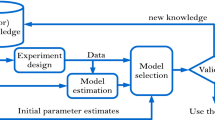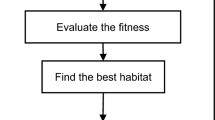Abstract
Modeling of nonlinear industrial systems embraces two key stages: selection of a model structure with a compact parameter list, and selection of an algorithm to estimate the parameter list values. Thus, there is a need to develop a sufficiently adequate model to characterize the behavior of industrial systems to represent experimental data sets. The data collected for many industrial systems may be subject to the existence of high non-linearity and multiple constraints. Meanwhile, creating a thoroughgoing model for an industrial process is essential for model-based control systems. In this work, we explore the use of a proposed Enhanced version of the Cuckoo Search (ECS) algorithm to address a parameter estimation problem for both linear and nonlinear model structures of a real winding process. The performance of the developed models was compared with other mainstream meta-heuristics when they were targeted to model the same process. Moreover, these models were compared with other models developed based on some conventional modeling methods. Several evaluation tests were performed to judge the efficiency of the developed models based on ECS, which showed superior performance in both training and testing cases over that achieved by other modeling methods.













Similar content being viewed by others
References
Akaike, H., Petrov, B. N., & Csaki, F. (1973). Second international symposium on information theory.
Al-Hiary, H., Braik, M., Sheta, A., & Ayesh, A. (2008). Identification of a chemical process reactor using soft computing techniques. In IEEE international conference on fuzzy systems, 2008. FUZZ-IEEE 2008. (IEEE world congress on computational intelligence) (pp. 845–853). IEEE.
Ayough, A., & Khorshidvand, B. (2019). Designing a manufacturing cell system by assigning workforce. Journal of Industrial Engineering and Management, 12(1), 13–26.
Aziz, M. A. E., & Hassanien, A. E. (2018). Modified cuckoo search algorithm with rough sets for feature selection. Neural Computing and Applications, 29(4), 925–934.
Babuska, R. (1998). Fuzzy modeling and identification toolbox, 204. Delft University of Technology, The Netherland. http://lcewww.et.tudelft.nl/bubuska
Babuška, R., & Verbruggen, H. (2003). Neuro-fuzzy methods for nonlinear system identification. Annual Reviews in Control, 27(1), 73–85.
Braatz, R. D., Ogunnaike, B. A., & Featherstone, A. P. (1996). Identification, estimation, and control of sheet and film processes. IFAC Proceedings Volumes, 29(1), 6638–6643.
Braik, M. (2021). A hybrid multi-gene genetic programming with capuchin search algorithm for modeling a nonlinear challenge problem: Modeling industrial winding process, case study. Neural Processing Letters, 1–44.
Braik, M., Al-Zoubi, H., & Al-Hiary, H. (2021). Artificial neural networks training via bio-inspired optimisation algorithms: Modelling industrial winding process, case study. Soft Computing, 25(6), 4545–4569.
Braik, M., Sheta, A., & Arieqat, A. (2008). A comparison between GAs and PSO in training ANN to model the TE chemical process reactor. In Proceedings of the AISB 2008 convention in communication, interaction and social intelligence (Vol. 1, pp. 24).
Braik, M., Sheta, A., Turabieh, H., & Alhiary, H. (2021). A novel lifetime scheme for enhancing the convergence performance of salp swarm algorithm. Soft Computing, 25(1), 181–206.
Chang, Y.-W., Hsieh, C.-J., Chang, K.-W., Ringgaard, M., & Lin, C.-J. (2010). Training and testing low-degree polynomial data mappings via linear svm. Journal of Machine Learning Research, 11(Apr), 1471–1490.
Chicco, D., Warrens, M. J., & Jurman, G. (2021). The coefficient of determination r-squared is more informative than smape, mae, mape, mse and rmse in regression analysis evaluation. PeerJ Computer Science, 7, e623.
Chu, X., Nian, X., Liu, J., & Liao, Y. (2017). Robust fault detection for multi-motor winding system based on disturbance observer and sliding-mode observer. In 2017 11th Asian control conference (ASCC) (pp. 1519–1524). IEEE.
Cross, P., & Ma, X. (2014). Nonlinear system identification for model-based condition monitoring of wind turbines. Renewable Energy, 71, 166–175.
Dao, S. D., Abhary, K., & Marian, R. (2017). Optimisation of assembly scheduling in vcim systems using genetic algorithm. Journal of Industrial Engineering International, 13(3), 275–296.
Dixit, S. R., Das, S. R., & Dhupal, D. (2019). Parametric optimization of nd: Yag laser microgrooving on aluminum oxide using integrated rsm-ann-ga approach. Journal of Industrial Engineering International, 15(2), 333–349.
Faris, H., & Sheta, A. (2013). Identification of the tennessee eastman chemical process reactor using genetic programming. International Journal of Advanced Science and Technology, 50, 121–140.
Faris, H., Sheta, A., & Öznergiz, E. (2013). Modelling hot rolling manufacturing process using soft computing techniques. International Journal of Computer Integrated Manufacturing, 26(8), 762–771.
Faris, H., Sheta, A. F., & Öznergiz, E. (2016). Mgp-cc: A hybrid multigene gp-cuckoo search method for hot rolling manufacture process modelling. Systems Science and Control Engineering, 4(1), 39–49.
Friedman, M. (1937). The use of ranks to avoid the assumption of normality implicit in the analysis of variance. Journal of the American Statistical Association, 32(200), 675–701.
Gandomi, A. H., Yang, X.-S., & Alavi, A. H. (2013). Cuckoo search algorithm: A metaheuristic approach to solve structural optimization problems. Engineering with Computers, 29(1), 17–35.
Guidorzi, R. (2003). Multivariable system identification: From observations to models. Bologna: Bononia University Press.
Holm, S. (1979). A simple sequentially rejective multiple test procedure. Scandinavian Journal of Statistics, 65–70.
Hussian, A., Sheta, A., Kamel, M., Telbaney, M., & Abdelwahab, A. (2000). Modeling of a winding machine using genetic programming. In Proceedings of the 2000 congress on evolutionary computation, 2000 (Vol. 1, pp. 398–402). IEEE.
İnci, M., & Caliskan, A. (2020). Performance enhancement of energy extraction capability for fuel cell implementations with improved cuckoo search algorithm. International Journal of Hydrogen Energy, 45(19), 11309–11320.
Jain, M., Singh, V., & Rani, A. (2019). A novel nature-inspired algorithm for optimization: Squirrel search algorithm. Swarm and Evolutionary Computation, 44, 148–175.
Kamrani, E. (2010). Modeling and forecasting long-term natural gas (ng) consumption in Iran, using particle swarm optimization (pso).
Karthik, G. V. S. K., & Deb, S. (2018). A methodology for assembly sequence optimization by hybrid cuckoo-search genetic algorithm. Journal of Advanced Manufacturing Systems, 17(01), 47–59.
Lennart, L. (1994). From data to model: A guided tour of system identification.
Ljung, L. (1987). Theory for the user. New York: Prentice Hall.
Mello, R. G. T., Oliveira, L. F., & Nadal, J. (2007). Digital butterworth filter for subtracting noise from low magnitude surface electromyogram. Computer Methods and Programs in Biomedicine, 87(1), 28–35.
Mirjalili, S. (2016). Dragonfly algorithm: A new meta-heuristic optimization technique for solving single-objective, discrete, and multi-objective problems. Neural Computing and Applications, 27(4), 1053–1073.
Moslemipour, G. (2018). A hybrid cs-sa intelligent approach to solve uncertain dynamic facility layout problems considering dependency of demands. Journal of Industrial Engineering International, 14(2), 429–442.
Mousavi, S. H., Nazemi, A., & Hafezalkotob, A. (2015). Using and comparing metaheuristic algorithms for optimizing bidding strategy viewpoint of profit maximization of generators. Journal of Industrial Engineering International, 11(1), 59–72.
Nelles, O. (2002). Nonlinear system identification.
Nikabadi, M., & Naderi, R. (2016). A hybrid algorithm for unrelated parallel machines scheduling. International Journal of Industrial Engineering Computations, 7(4), 681–702.
Noura, H., Theilliol, D., Ponsart, J.-C., & Chamseddine, A. (2009). Fault-tolerant control systems: Design and practical applications. Berlin: Springer.
Nozari, H. A., Banadaki, H. D., Mokhtare, M., & Vahed, S. H. (2012). Intelligent non-linear modelling of an industrial winding process using recurrent local linear neuro-fuzzy networks. Journal of Zhejiang University SCIENCE C, 13(6), 403–412.
Ogunjuyigbe, A. S. O., Ayodele, T. R., & Adetokun, B. B. (2018). Modelling and analysis of dual stator-winding induction machine using complex vector approach. International Journal Engineering Science and Technology, 21(3), 351–363.
Öznergiz, E., Özsoy, C., Delice, I. I., & Kural, A. (2009). Comparison of empirical and neural network hot-rolling process models. Proceedings of the Institution of Mechanical Engineers, Part B: Journal of Engineering Manufacture, 223(3), 305–312.
Parant, F., Coeffier, C., & Iung, C. (1992). Modeling of web tension in a continuous annealing line. Iron and Steel Engineer (USA), 69(11), 46–49.
Pascual, D. G. (2015). Artificial intelligence tools: Decision support systems in condition monitoring and diagnosis. New York: CRC Press.
Pavlyukevich, I. (2007). Lévy flights, non-local search and simulated annealing. Journal of Computational Physics, 226(2), 1830–1844.
Pereira, I., Madureira, A., & e Silva, E.C., & Abraham, A. (2021). A hybrid metaheuristics parameter tuning approach for scheduling through racing and case-based reasoning. Applied Sciences, 11(8), 3325.
Quinn, T. J., & Deriso, R. B. (1999). Quantitative fish dynamics. Oxford: Oxford university Press.
Reynolds, A. M., & Frye, M. A. (2007). Free-flight odor tracking in drosophila is consistent with an optimal intermittent scale-free search. PLOS ONE, 2(4), e354.
Sadati, N., Chinnam, R. B., & Nezhad, M. Z. (2018). Observational data-driven modeling and optimization of manufacturing processes. Expert Systems with Applications, 93, 456–464.
Santillan, J. H., Tapucar, S., Manliguez, C., & Calag, V. (2018). Cuckoo search via lévy flights for the capacitated vehicle routing problem. Journal of Industrial Engineering International, 14(2), 293–304.
Schlei-Peters, I., Wichmann, M. G., Matthes, I.-G., Gundlach, F.-W., & Spengler, T. S. (2008). Integrated material flow analysis and process modeling to increase energy and water efficiency of industrial cooling water systems. Journal of Industrial Ecology, 22(1), 41–54.
Sheta, A., Braik, M., & Al-Hiary, H. (2019). Modeling the tennessee eastman chemical process reactor using bio-inspired feedforward neural network (bi-ff-nn). The International Journal of Advanced Manufacturing Technology, 1–22.
Sheta, A.F., Braik, M., & Al-Hiary, H. (2009). Identification and model predictive controller design of the Tennessee Eastman Chemical Process using ANN. In Proceedings of the international conference on artificial intelligence (ICAI’09), July 13–16, USA, (Vol. 1, pp. 25–31).
Sheta, A.F., Braik, M., Öznergiz, E., Ayesh, A., & Masud, M. (2013). Design and automation for manufacturing processes: An intelligent business modeling using adaptive neuro-fuzzy inference systems. In Business intelligence and performance management (pp. 191–208). Springer.
Shlesinger, M. F. (2006). Mathematical physics: Search research. Nature, 443(7109), 281.
Sievers, L., Balas, M. J., & von Flotow, A. (1988). Modeling of web conveyance systems for multivariable control. IEEE Transactions on Automatic Control, 33(6), 524–531.
Tahmassebi, A., & Gandomi, A. H. (2018). Building energy consumption forecast using multi-objective genetic programming. Measurement, 118, 164–171.
Torres, P. J. R., Mercado, E. S., & Rifón, L. A. (2018). Probabilistic Boolean network modeling of an industrial machine. Journal of Intelligent Manufacturing, 29(4), 875–890.
Van Welden, D. (2000). Induction of predictive models for dynamical systems via data mining. Ph.d thesis, Ghent University.
Wasserman, L. (2000). Bayesian model selection and model averaging. Journal of Mathematical Psychology, 44(1), 92–107.
Wei, Y., Qiu, J., Lam, H.-K., & Ligang, W. (2017). Approaches to t-s fuzzy-affine-model-based reliable output feedback control for nonlinear ito stochastic systems. IEEE Transactions on fuzzy systems, 25(3), 569–583.
Willmott, C. J., & Matsuura, K. (2005). Advantages of the mean absolute error (mae) over the root mean square error (rmse) in assessing average model performance. Climate Research, 30(1), 79–82.
Yang, X.-S., & Deb, S. (2009). Cuckoo search via lévy flights. In Nature and biologically inspired computing, 2009. NaBIC 2009. world congress on (pp. 210–214). IEEE.
Yang, X.-S., & Deb, S. (2010). Engineering optimisation by cuckoo search. International Journal of Mathematical Modelling and Numerical Optimisation, 1(4), 330–343.
Yang, X.-S., & Deb, S. (2014). Cuckoo search: Recent advances and applications. Neural Computing and Applications, 24(1), 169–174.
Yıldız, A. R. (2008) Hybrid taguchi-harmony search algorithm for solving engineering optimization problems. International Journal of Industrial Engineering, 15(3), 286–293.
Zadeh, L. (1956). On the identification problem. IRE Transactions on Circuit Theory, 3(4), 277–281.
Zhang, Z., Hong, W.-C., & Li, J. (2020). Electric load forecasting by hybrid self-recurrent support vector regression model with variational mode decomposition and improved cuckoo search algorithm. IEEE Access, 8, 14642–14658.
Zingg, D. W., Nemec, M., & Pulliam, T. H. (2008). A comparative evaluation of genetic and gradient-based algorithms applied to aerodynamic optimization. European Journal of Computational Mechanics/Revue Européenne de Mécanique Numérique, 17(1–2), 103–126.
Zucchini, W. (2000). An introduction to model selection. Journal of Mathematical Psychology, 44(1), 41–61.
Acknowledgements
The authors would like to acknowledge Taif University Researchers Supporting Project Number (TURSP-2020/73), Taif University, Taif, Saudi Arabia.
Author information
Authors and Affiliations
Corresponding author
Additional information
Publisher's Note
Springer Nature remains neutral with regard to jurisdictional claims in published maps and institutional affiliations.
Rights and permissions
About this article
Cite this article
Braik, M., Sheta, A., Al-Hiary, H. et al. Enhanced cuckoo search algorithm for industrial winding process modeling. J Intell Manuf 34, 1911–1940 (2023). https://doi.org/10.1007/s10845-021-01900-1
Received:
Accepted:
Published:
Issue Date:
DOI: https://doi.org/10.1007/s10845-021-01900-1




